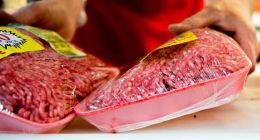NASA has invented a new super material built to withstand extreme conditions.
The metal alloy was created using a 3D printing process and could revolutionise air and space travel.
It can endure temperatures over 2,000F (1,090C) and is more malleable than existing state-of-the-art alloys.
Called GRX-810, the material can also survive more than 1,000 times longer than other alloys, Nasa said in a statement last week.
“These new alloys can be used to build aerospace parts for high-temperature applications, like those inside aircraft and rocket engines,” Nasa said.
GRX-810 is an oxide dispersion strengthened (ODS) alloy, meaning chemical compounds called oxides are embedded across its surface.


ODS alloys can withstand harsher conditions before reaching their breaking point.
That makes them perfect for the brutal environments in and around aircraft and jet engines.
To figure out the arrangement that would make the material as durable as possible, engineers turned to computer models.
They used the models to simulate the thermodynamic performance of the alloy and then 3D-printed it.
They arrived at the optimal design after around 30 simulations in a process of trial and error that is said to improve efficiency.
Nasa said that the design and creation of aerospace materials used to take years but thanks to computer models can now take weeks.
At temperatures of 2,000F, GRX-810 is twice as resistant to fracturing as other state-of-the-art alloys.
It also offers three and a half times the flexibility without cracking when bent and more than 1,000 times the durability under stress.
Nasa says the material opens up new possibilities in aircraft design and could allow for lighter components.
Jet engines built using the material would lose less fuel and aircraft would have lower operating and maintenance costs.
“These alloys have major implications for the future of sustainable flight,” Nasa said.
“For example, when used in a jet engine, the alloy’s higher temperature and increased durability capability translates into reduced fuel burn and lower operating and maintenance costs.


“This alloy also affords engine part designers new flexibilities like lighter materials paired with vast performance improvements.
“Designers can now contemplate tradeoffs they couldn’t consider before, without sacrificing performance.”
Best Phone and Gadget tips and hacks
Looking for tips and hacks for your phone? Want to find those secret features within social media apps? We have you covered…
We pay for your stories! Do you have a story for The Sun Online Tech & Science team? Email us at [email protected]
This post first appeared on Thesun.co.uk











